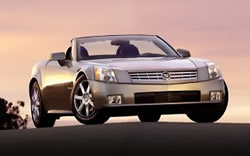 There's
a new way to spell sex appeal: XLR. There's
a new way to spell sex appeal: XLR.
Cadillac's
2004 XLR roadster is, as one company official put it, a "way to get noticed."
And that's even if you're the 54-year-old male who Cadillac officials believe
is likely to be the typical XLR buyer.
Even
this Baby Boomer — well to do, to be sure, with annual household income of more
than $250,000 — will look stylish and hip in this low-riding two-seater.
Maybe
it's the fact the XLR is a luxury convertible whose low production numbers —
3,000 to 5,000 are expected to be built and sold in the first year —
mean few people will be able to get one.
Perhaps
it's the fun use of technology. For example, there's no need to get out a key
to open the door of the XLR. The doors have no keyholes. A driver
can press the key fob to unlock the car or, more simply, just have the keyless
remote device in a pocket or purse she's carrying and then touch the subtly hidden
door handle. Voila! The XLR door unlocks and unlatches automatically.
Halo
car for Cadillac
With
a starting manufacturer's suggested retail price, including destination charge,
of just over $76,000, the XLR is, indeed, a special kind of ride. Forget Cadillac's
previous unsuccessful attempt at a luxury roadster. Built at the same assembly
plant that produces the Chevrolet Corvette, the XLR is no Cadillac Allante.
The
XLR is the new Cadillac halo car — designed to prove that the years of unimpressive
cars at America's best-known luxury brand have come to an end.
If
the XLR's expressive looks don't convince you, its performance and handling should.
Northstar power
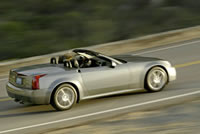 Mated
to a five-speed automatic transmission, the next-generation Northstar V8 provides
the XLR's power in a silky smooth fashion. Mated
to a five-speed automatic transmission, the next-generation Northstar V8 provides
the XLR's power in a silky smooth fashion.
In fact, shifts from gear to gear
in the automatic mode were so smooth in the test car, I had to watch the tachometer
needle to note the shift points.
The
transmission also has a "manumatic" mode that lets a driver shift gears
for himself, sans clutch pedal. A true manual transmission isn't offered. Cadillac
officials boast the XLR's maximum 320 horsepower tops the class for competing,
naturally aspirated, V8-powered roadsters.
Indeed, it's more than the 300
horsepower in the Lexus SC 430.
It's also more than the 302 horses in the
Mercedes-Benz SL500 with naturally aspirated V8. But Mercedes also offers two
other SL versions — a supercharged V8-powered SL55 AMG and a V12-powered SL600.
Both provide a maximum 493 horsepower.
The
XLR's torque is rated at 310 foot-pounds at 4,400 rpm, which is less than that
of competitors. For example, the SC 430 provides 325 foot-pounds of torque at
3,400 rpm, and the SL500 generates 339 foot-pounds between 2,700 and 4,250 rpm.
But Cadillac notes the XLR is lighter in weight and thus can feel more sprightly and responsive. Specifically, curb weight for the XLR is 418 pounds lighter than that of the SL500 and 193 pounds lighter than SC 430's.
As a result, zero to 60 miles an hour is 5.8 seconds, according to Cadillac, and there's enough zip in the XLR to push back the heads of the driver and passenger when the accelerator is slammed down hard. Mercedes reports a 0-to-60-mph time of 6.1 seconds for its SL500 and Lexus reports 5.9 seconds for its SC 430.
The test XLR sure didn't lack power. I passed other vehicles on the highway without fuss, and I merged into city traffic with ease. Actually, I sometimes had people make room for me and the XLR, because they were so interested in seeing this new, showy car. See what I mean about sex appeal and attention?
Composed, comfortable ride
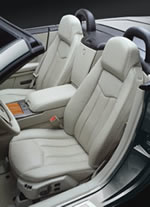
Riding on a platform that also will carry the Chevy C6 Corvette, the rear-drive XLR has a firm, controlled feel and goes into curves and corners with impressive composure.
The XLR is low slung and a rather wide car — wider by 0.3 inch than the competing Mercedes SL and Lexus SC 430 — so it maintains a nice, flat attitude in the curves. Steering is crisp, too.
But the ride isn't punishing, thanks to special tuning that differentiates the suspension from that of the 2005 Corvette. Specifically, the XLR uses the Vette's short/long arm double wishbone arrangement for the front and rear suspensions, but the XLR's Magnetic Ride Control shock absorbers are tuned for less racetrack orientation.
The XLR is one of the first vehicles with Magnetic Ride Control. It's a technology that uses tiny iron particles in the dampers to adjust the damping effort of the shocks in just milliseconds as it receives constant data from sensors that read the road surface.
A driver can't tell what the system is changing at any given time because changes are fluid and subtle. But a driver will find the XLR, with its 18-inch, Michelin run-flat tires, to be a well-mannered, responsive car that's easy to drive in city traffic, too. These run flats are standard because trunk space that might be used for a spare tire in a regular car is used here for a bit of cargo room and, most importantly, stowage of the XLR's retractable hardtop.
Fancy-working top
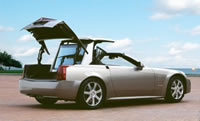 The XLR's retractable hardtop almost seems to put on a show as its hydraulics work to open the trunk, lift the car's roof and fold and arrange the things inside the rear of the car before allowing the trunk lid to go back down. The XLR's retractable hardtop almost seems to put on a show as its hydraulics work to open the trunk, lift the car's roof and fold and arrange the things inside the rear of the car before allowing the trunk lid to go back down.
It takes about 30 seconds for the XLR to go from hard top to topless, and all the driver has to do is push a button. The rear quarter windows go back as the hardtop is removed.
With the hard top stowed at the rear, trunk space is just 4.4 cubic feet in the XLR. When the top is on the car, however, trunk space is a full 11.6 cubic feet. This compares with a maximum 8.8 cubic feet in the SC 430 and 10.2 in the SL500.
Odds and ends
The interior of the XLR is comfortable and doesn't convey a cramped feeling like some two-seaters do. Real eucalyptus wood trim adds an eye-catching, light accent, but I wish the leather bucket seats had a richer look.
There's no ignition keyhole inside. A driver pushes a button on the dashboard to start the car. You must have the keyless remote somewhere nearby, however.
Italian jeweler Bvlgari designed the XLR's gauges, so "Bvalgari" is arrayed around the large speedometer. It looks awkward because it doesn't also extend over the adjacent, same-sized tachometer.
But I liked the XLR's head-up display with large, green numbers and letters. When the car is started, it immediately displays the letters "XLR" on the windshield, which is cool.
The only option on the XLR is XM satellite radio, but I wish there were choices for different wheels and tires.
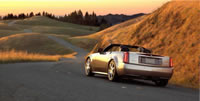 There's no track record yet on XLR quality, but there's a lot of complicated mechanicals and electronics in this car. Cadillac insists that any dealers who sell the car have to get special training for at least one service technician. There's no track record yet on XLR quality, but there's a lot of complicated mechanicals and electronics in this car. Cadillac insists that any dealers who sell the car have to get special training for at least one service technician.
Snafus could be complex. For example, that for some reason, the car loses power and you want to get inside your XLR. With no door keyhole, you can't just unlock the car. Rather, a driver must lift a little tab at the rear bumper and put the key in there to manually open the trunk lid. Then, she has to reach into the left side wall of the trunk to activate a manual driver door release. Whew!
The XLR is priced between competitors. Starting MSRP, including destination charge, is just over $63,000 for a 2004 Lexus SC 430 and $88,500 for a 2004 Mercedes-Benz SL500.
Click here for more information on the Cadillac XLR.
For the Cadillac 2004 Model Guide : Click Here |